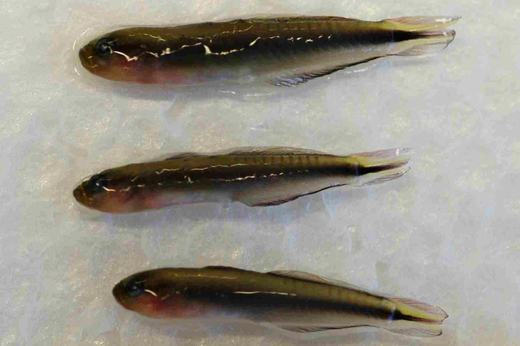Blackmargin Dartfish, Parioglossus marginalis Rennis & Hoese 1985
Other Names: Port Hacking Dart-goby

A Blackmargin Dartfish, Parioglossus marginalis, from upstream of the Roseville Bridge, Middle Harbour, Sydney, New South Wales. Source: Amanda Hay / © Australian Museum. License: CC by Attribution-NonCommercial
Summary:
A brownish dartfish with a white belly, a purple stripe above a black mid-lateral stripe, and greenish-blue patches on the gill cover and pectoral-fin base. Males have a purple margin on the second dorsal fin and upper and lower lobes of the caudal fin, the outer half of the anal fin black, and the mid-lateral stripe extends to the rear of the caudal fin. Females have pale dorsal and anal fins, the upper half of the caudal fin dusky, and 3-4 solid to broken black vertical bands along the middle caudal-fin rays.
Although Blackmargin Dartfish also occur in northern New Zealand, the species is thought to have been introduced from Australia via the ballast water of ships.
Although Blackmargin Dartfish also occur in northern New Zealand, the species is thought to have been introduced from Australia via the ballast water of ships.
Cite this page as:
Bray, D.J. 2017, Parioglossus marginalis in Fishes of Australia, accessed 27 Jun 2025, https://fishesofaustralia.net.au/Home/species/2944
Blackmargin Dartfish, Parioglossus marginalis Rennis & Hoese 1985
More Info
|
Distribution |
Endemic to eastern Australia from the Hawkesbury River, Sydney, to Wagonga Inlet, Narooma, New South Wales. The Blackmargin Dartfish also occurs in the North Island of New Zealand, where it has been found at Kaitoke wetland, Great Barrier Island and Waitangi Stream at Tom Bowling Bay, North Cape. It may have been introduced to New Zealand via ships' ballast water. Inhabits the upper reaches of estuaries, harbours and coastal bays, sometimes occurring amongst mangroves and in lower stretches of rivers. Blackmargin Dartfish hover in mid-water in small to large schools over sandy and rocky bottoms. |
|
Features |
Dorsal fin V-VI + I, 16-18; Anal fin 1,17-18; Pectoral fin 17-19; Caudal fin (branched rays) 7 + 6; Longitudinal scale count 90-105; Gill rakers 3-4 + 14-15. |
|
Etymology |
The specific name marginalis is from the Latin, marginalis, meaning 'border', 'edge', in reference to the dark margins of the dorsal and ventral caudal lobes and margin of anal fin in males, and dark margin around the anus of the females. |
|
Species Citation |
Parioglossus marginalis Rennis & Hoese, 1985, Rec. Aust. Mus. 36: 179, figs 9, 23-24. Type locality: Audley National Park, Port Hacking, NSW. |
|
Author |
Bray, D.J. 2017 |
Blackmargin Dartfish, Parioglossus marginalis Rennis & Hoese 1985
References
David, B., Franklin, P., Closs, G., Hitchmough, R., Allibone, R, Ling, N., Crow, S. & West, D 2014. Parioglossus marginalis. The IUCN Red List of Threatened Species. Version 2014.3.
McDowall, R.M. 2001. Parioglossus (Teleostei: Gobioidei: Microdesmidae) in New Zealand. New Zealand Journal of Marine and Freshwater Research 35: 165-172.
Rennis, D.S. & Hoese, D.F. 1985. A review of the genus Parioglossus, with descriptions of six new species (Pisces : Gobioidei). Records of the Australian Museum 36: 169-201 figs 1-37
Wang, R. & Winterbottom, R. 2006. Osteology and phylogeny of Parioglossus (Teleostei, Gobioidei), with a revised key to the species. Zootaxa 1131: 1-32.


